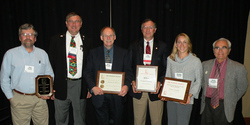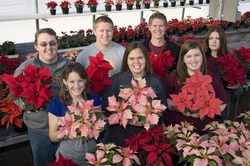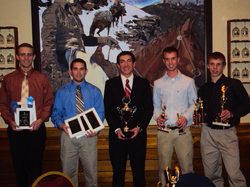 University of Minnesota Wildlife Professor Dan Svedarsky was among 8 individuals recognized as fellows at the fall annual meeting of The Wildlife Society in Snowbird, Utah. Svedarsky is a research biologist at the Northwest Research and Outreach Center (NWROC) and professor of natural resources at the University of Minnesota, Crookston.
University of Minnesota Wildlife Professor Dan Svedarsky was among 8 individuals recognized as fellows at the fall annual meeting of The Wildlife Society in Snowbird, Utah. Svedarsky is a research biologist at the Northwest Research and Outreach Center (NWROC) and professor of natural resources at the University of Minnesota, Crookston. The title of fellow recognizes members of The Wildlife Society who have distinguished themselves through exception service to the wildlife profession. Svedarsky received the Minnesota Award from the Minnesota Chapter of The Wildlife Society in 1999 and served as national president of the 9,000 member organization in 2007-08. He currently chairs the College and University Wildlife Education Working Group of The Wildlife Society which organized a symposium at the Utah meeting on educating the wildlife professional. Svedarsky presented a paper at the symposium along with U of M, Crookston colleagues, Phil Baird and John Loegering. Svedarsky also serves on a USDA-sponsored, Blue Ribbon Panel with 17 representatives from universities and conservation agencies in the U.S. and Canada who are reviewing the future of the wildlife profession and identifying recruitment strategies for new employees.
In his research involvements, Svedarsky and his graduate students study prairie and wetland ecology and management with one of his favorite subjects being greater prairie chickens. Most of his studies have been conducted on the Glacial Ridge National Wildlife Refuge, the largest prairie and wetland restoration project in North America located just east of Crookston. Recently, one of his graduate students studied the summer ecology of female prairie chickens at Glacial Ridge and then fall trapped radio-tagged birds for translocation to Wisconsin where numbers are dangerously low. The study was sponsored by the Wisconsin Department of Natural Resources.
Svedarsky joined other Minnesotans who were honored in Utah with national awards.

Dr. Doug Johnson, a federal biologist in the Department of Fisheries, Wildlife, and Conservation Biology at the U of M, St. Paul, received the Aldo Leopold Memorial Award. This is the highest honor bestowed by The Wildlife Society in honor of the founder of the profession. John Moriarty, biologist with Ramsey County, (Minn.) received the Jim McDonough Award to recognize a certified wildlife biologist who has made a significant contribution to the profession by implementing wildlife programs and developing new techniques. Meadow Kouffeld, a doctoral student working with Dr. Ralph (Rocky) Gutierrez at the U of M, St. Paul, received the Donald Rusch Memorial Game Bird Research Scholarship for her work with ruffed grouse.
The Northwest Research and Outreach Center is part of a system of research centers in different regions of Minnesota conducting research on soils, agronomy, entomology, and natural resources affiliated with the College of Food, Agriculture, and Natural Resource Sciences (CFANS) of the University of Minnesota. To learn more, visit http://nwroc.crk.umn.edu.
In the photo (l to r): John Moriarty; Bruce Leopold, President of The Wildlife Society; Doug Johnson; Dan Svedarsky; Meadow Kouffeld; and Rocky Gutierrez.
Contact: Maureen Aubol, office supervisor, NWROC; 218-281-8602 (aubo0002@umn.edu); Dan Svedarsky, research biologist, NWROC, 218-281-8129, (dsvedars@umn.edu)



